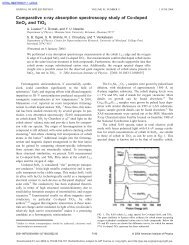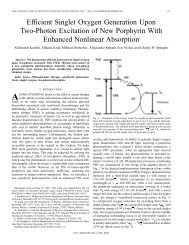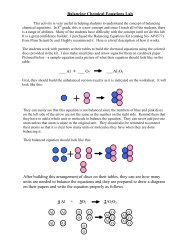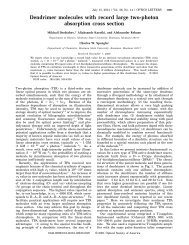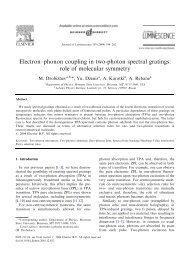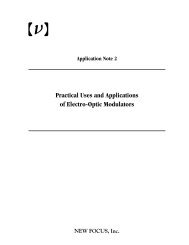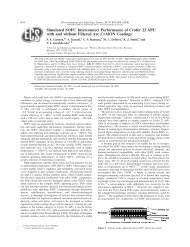Defects in inorganic photorefractive materials and their investigations
Defects in inorganic photorefractive materials and their investigations
Defects in inorganic photorefractive materials and their investigations
You also want an ePaper? Increase the reach of your titles
YUMPU automatically turns print PDFs into web optimized ePapers that Google loves.
<strong>Defects</strong> <strong>in</strong> <strong>in</strong>organic <strong>photorefractive</strong> <strong>materials</strong> <strong>and</strong> <strong>their</strong> <strong>in</strong>vestigations 29<br />
Photorefractivity <strong>in</strong> the sillenites was usually studied with green or blue<br />
light, but there is a need to improve <strong>their</strong> properties <strong>in</strong> the red <strong>and</strong> near-IR<br />
<strong>in</strong> order benefit from laser diodes <strong>in</strong> this spectral region. The spectroscopic<br />
results reported above suggest that the shallow defects lead<strong>in</strong>g to b<strong>and</strong>s ’4’<br />
<strong>and</strong> ’5’ <strong>in</strong> Fig. 6 can be used for that purpose. Their electron population<br />
can be raised substantially via a prelim<strong>in</strong>ary blue homogeneous illum<strong>in</strong>ation.<br />
For example, an enhancement of the beam coupl<strong>in</strong>g at 1.06 µm was observed<br />
[167] <strong>in</strong> undoped BTO by preexposure to visible light. Consistently with the<br />
possible assignment of b<strong>and</strong>s ’4’ <strong>and</strong> ’5’ to oxygen vacancies, crystals grown<br />
under argon show an unusual <strong>photorefractive</strong> sensitivity <strong>and</strong> a remarkable<br />
operation speed <strong>in</strong> this spectral region [168]; the photoconductivity <strong>in</strong> red<br />
light is two orders of magnitude higher than <strong>in</strong> crystals grown <strong>in</strong> the presence<br />
of oxygen [169].<br />
6.3 Extr<strong>in</strong>sic defects<br />
In pr<strong>in</strong>ciple, the <strong>in</strong>troduction of extr<strong>in</strong>sic defects offers more choices for tailor<strong>in</strong>g<br />
the <strong>photorefractive</strong> properties of the sillenites. A few encourag<strong>in</strong>g results<br />
were obta<strong>in</strong>ed by dop<strong>in</strong>g with transition metal ions. Cr improves the diffraction<br />
efficiency <strong>and</strong> <strong>in</strong>creases the response speed of BSO at 633 nm [170].<br />
Holographic grat<strong>in</strong>gs were recently recorded <strong>in</strong> the near IR <strong>in</strong> <strong>in</strong> rutheniumdoped<br />
BTO [171] <strong>and</strong> BSO [172] samples. In the case of Bi 12 Ti 0.76 V 0.24 O 20 ,<br />
homogeneous illum<strong>in</strong>ation <strong>and</strong> the application of an external electric field after<br />
writ<strong>in</strong>g enhance the diffraction efficiency by a factor of almost 40 [173] at<br />
514 nm. The mechanisms underly<strong>in</strong>g these experimental observations are far<br />
from be<strong>in</strong>g understood.<br />
In spite of <strong>in</strong>tensive research with absorption <strong>and</strong> CD spectroscopies [174],<br />
most progress with respect to the def<strong>in</strong>ite assignment of absorption b<strong>and</strong>s<br />
has been reached by MCD <strong>and</strong> ODMR studies [175]. Many defects have been<br />
identified <strong>in</strong> this way <strong>and</strong> <strong>their</strong> optical excitations were greatly clarified: Cr 4+<br />
M<br />
<strong>and</strong> Cr 5+<br />
M<br />
[146], Mn5+<br />
M<br />
<strong>and</strong> Mn4+<br />
M<br />
[146, 176, 177], Cu2+<br />
M<br />
[146] <strong>and</strong> Cu2+<br />
Bi<br />
[178,<br />
175], Fe 3+<br />
M<br />
[145, 146], V4+<br />
M<br />
[177], Co2+<br />
M<br />
<strong>and</strong> Ni2+<br />
M<br />
[146], <strong>and</strong> Run+<br />
Bi<br />
(n =3− 5)<br />
[172, 179]. Until now, V M was thought to be always <strong>in</strong> the 5+ diamagnetic<br />
state s<strong>in</strong>ce no EPR signal could be found by conventional means [180].<br />
As has been demonstrated above with the <strong>in</strong>tr<strong>in</strong>sic defects, most detailed<br />
<strong>in</strong>formation is obta<strong>in</strong>ed when experiments are carried out <strong>in</strong> the bleached <strong>and</strong><br />
colored states, but also <strong>in</strong> the near-IR (likely to be connected with <strong>in</strong>ternal<br />
transitions) as well as <strong>in</strong> the visible (charge transfer or <strong>in</strong>tervalence transitions).<br />
Fig. 14 illustrates such <strong>in</strong>formation related to Cr-dop<strong>in</strong>g [146, 175]. In<br />
the <strong>in</strong>itial state, MCD-active Bi 4+<br />
M<br />
is absent <strong>and</strong> the broad features observed <strong>in</strong><br />
the visible are thus associated with chromium. Very characteristic MCD (<strong>and</strong><br />
CD) sharp features are detected for Cr 4+<br />
Ge (3 A 2 → 1 E transition) <strong>and</strong> Cr 5+<br />
Ge<br />
( 2 E → 2 T 2 ) <strong>in</strong> the near-IR. The coexistence of both charge states <strong>in</strong>dicates<br />
that the Fermi-level is p<strong>in</strong>ned at the Cr 4+/5+<br />
Ge<br />
level <strong>in</strong> thermal equilibrium.<br />
Illum<strong>in</strong>ation with E





